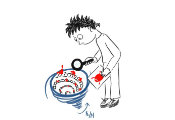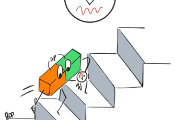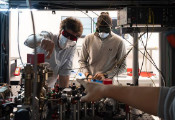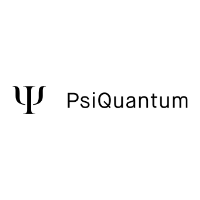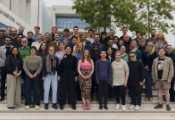Hidden Quantum Patterns: Exploring Simulations of Exotic Matter
July 31, 2025 -- Some materials behave in surprisingly strange ways when cooled to very low temperatures. Among the strangest is the quantum spin liquid, in which the material's atoms don’t settle into any regular pattern, but instead stay connected through long-range quantum entanglement. These unusual states of matter might one day be useful for quantum computing.
But identifying a true quantum spin liquid isn’t easy. Scientists can’t just look at how the atoms are arranged. Instead, they look for signs of deep, invisible connections between atoms.
One way to do this is to calculate a number called topological entanglement entropy, or TEE. If this number is big enough, it means the atoms are entangled in a way that’s deeply built into the system, like a hidden structure that stays intact no matter how the atoms move or shift, unless something dramatic happens, like a phase transition or a break in the material. It’s a bit like trying to tell if a jigsaw puzzle is solved by checking how tightly the pieces fit together instead of looking at the picture on the box.
Recently, researchers have used Rydberg atoms, individual atoms held in place and controlled by lasers, to create systems that look like spin liquids. But measuring TEE in these experiments isn’t yet possible.
This raises an important question: are these experiments really creating materials where atoms are linked in a deep and stable quantum way, or are they just showing some surface-level similarities without the real underlying structure?
A team led by Giuseppe Carleo at EPFL has now used a sophisticated computer simulation called time-dependent variational Monte Carlo (t-VMC) to mimic what happens in Rydberg atom experiments and check whether the atoms behave in the special, deeply connected way of a true quantum spin liquid. Their findings, published in Nature Physics, reveal subtle but important differences between the simulated states and an ideal topological quantum spin liquid.
The team built a detailed computer model of the experiment, carefully reproducing how the atoms are arranged in a kagome lattice, a pattern made of triangles, and how they interact with each other through long-range van der Waals forces, just like in the real experiments.
They used a method called time-dependent variational Monte Carlo (t-VMC), which is especially good at simulating quantum systems over time without getting bogged down by the complexity that limits other methods. This allowed them to estimate things that are impossible to measure in the lab, like TEE.
TEE describes the strength of the connection between parts of a system, regardless of the distance separating them. However, calculating a system’s TEE requires full knowledge of that system's quantum state, which current experiments can't provide. With the t-VMC simulation method, the researchers were able to model large systems of up to 288 atoms and estimate the TEE by analyzing how different parts of the system share quantum links.
The simulations showed many of the same features seen in real Rydberg experiments, including patterns that looked like those found in spin liquids. But when the researchers measured the TEE, the number that signals deep quantum connections, they found it never got high enough to confirm a truly topological state. The highest value was around 0.48, short of the expected 0.69.
Even though the simulated Rydberg atom system showed promising signs, it didn’t fully behave like a true quantum spin liquid. The TEE never reached the level that scientists consider the hallmark of this special state. And this wasn’t just because the simulated system was small or had the wrong shape; the shortfall pointed to something more fundamental.
The team also tested different ways of preparing the system, including slower, more careful (adiabatic) changes, but the TEE still didn’t reach the value expected for a fully topological state.
The study also shows how this kind of advanced simulation, which goes beyond simplified models and captures full experimental details, can bridge the gap between theory and experiment by revealing why experimental results may not match theoretical expectations for topological order. The approach could help refine future protocols for preparing and identifying topological states, not only in Rydberg systems but across quantum platforms.

